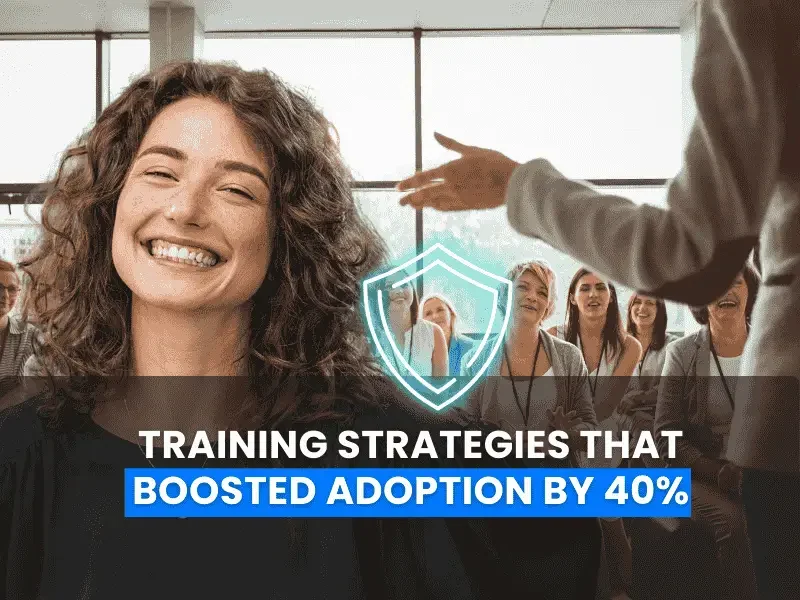SAP Articles
Change Management Plan: Fix Resistance Before It Starts
Noel DCosta
- Last Update :
Most resistance in ERP programs does not come out of nowhere. It builds slowly, well before the kickoff. You hear it in sideways comments during early meetings. You notice it in key stakeholders going quiet. And by the time formal change plans are drafted, the damage is usually already done. That’s when you realize that you need a change management plan!
So, this is one reason your Change Management Plan must not start late. Planning for adoption cannot wait until training begins. It needs to be tied directly to upstream design, governance, and resource allocation decisions. That’s what I have seen a lot.
That connection often goes missing, and leadership underestimates how early resistance takes root. This is where it often begins:
Critical users excluded from early design phases
Managers caught off guard by functional impacts
Vague communication that breeds second-guessing
Past failures causing quiet distrust
These are not purely communication issues. They are structural. If the Project Steering Committee is passive or disconnected, expect friction. If the Project Charter fails to mention behavior or adoption metrics, you lose leverage.
You need to look at people risks alongside delivery risks. Include behavior-related risk in your Risk Assessment Matrix. Not as a footnote, but as part of core governance.
Some early steps that help:
Use Stakeholder Mapping to track influence, not just role
Plan resource loads carefully to avoid burnout-driven pushback using this Resource Allocation Guide
Establish quality feedback loops tied to Quality Gates
One last thing. Be ready to adjust mid-flight. Even with preparation, new friction will appear. That is normal. Over-controlling it often backfires. The real goal is to detect it early, before it festers. The moment you see resistance as a signal, not a failure, you begin managing change properly.

Organizational change management helps companies transition smoothly when implementing new systems or processes by addressing the human aspects of change.It focuses on preparing employees through communication, training, and support strategies to reduce resistance and ensure adoption of the new ways of working.
10 Key Takeaways about a Change Management Plan
Hardwire change into the project structure. Most treat change as a parallel stream. Instead, embed behavioral outcomes into the Project Charter. This shifts change from an afterthought to a design input.
Include adoption thresholds in Quality Gates. Functional signoffs alone mislead. Use Quality Gates to assess not just “is it working” but “will people use it the way we expect.” Most sites miss this completely.
Model resource pressure zones. Overlooked often, resistance is frequently tied to team overload. Use structured Resource Allocation Planning to flag departments likely to burn out mid-implementation.
Do not copy-paste stakeholder lists. Many companies reuse old templates with standard department heads. Real influence varies project to project. Build it from scratch, and update it monthly.
Reverse-map resistance signals. If change pushback appears in testing, you are too late. Create a table of early warning indicators e.g. missed meetings, passive silence, vague feedback and connect them to specific team zones.
Use informal history audits. Past failed projects often shape unseen behavior. Spend a few hours gathering what people remember, not just what the documents say. It reveals more than formal lessons learned.
Lock in adoption KPIs before build starts. Do not wait for training to set metrics. Behavior needs anchoring in the blueprint stage, even if targets feel rough.
Rotate change leads by phase. One person owning change across a two-year cycle usually fails. Rotate ownership as the nature of resistance evolves.
Treat power users like co-authors. Invite them to design, not just test. It’s slower but avoids downstream resistance.
Revisit your Change Management Plan quarterly. It should change more often than the system build. Most forget this.
Importance of Communication in a Change Management Plan

Communication gets thrown around in every ERP change management plan. But it usually means newsletters, email updates, or generic town halls. That is not what matters. The real value lies in how information flows between levels and when. Timing changes the impact entirely.
A strong communication plan does more than share progress. It uncovers resistance before it hardens. It tests assumptions. It tells you whether the project’s logic even makes sense to users who are not in the room every day.
I remember a rollout where we communicated everything on time, but no one could explain why the process was changing. We had volume, but no clarity.
What most teams skip is the structure of communication paths. Not everyone should get the same message. And not every channel works the same way. For example:
Senior managers usually want business impacts first, not technical logic
End users need to hear from their direct manager, not a generic program lead
Functional leads respond better when given ownership of part of the messaging
Also, feedback is not passive. If your plan only includes outbound communication, it is already incomplete. Build feedback loops into Quality Gate reviews and link user sentiment with your risk matrix. That connection reveals weak spots before they go public.
Do not forget timing. Communicating too soon creates confusion. Too late and it feels forced. The window to earn trust is narrow. Use your project charter to set the tone, and let the change plan evolve with each phase.
In the end, communication is not a deliverable. It is an input. If treated like a checkbox, the project will feel like a surprise, even when everyone technically “knew” it was coming.
How to Execute an Organizational Change Management Plan

Implementing an organizational change management plan in an SAP or ERP project is definitely not a side activity. In my opinion after implementing several ERP projects, it is a core part of delivery that directly affects adoption, behavior, and long-term system value.
Most teams focus on systems, training, and timelines, but overlook how change impacts people structurally. Resistance does not come from lack of communication. It comes from unclear roles, reduced control, or broken trust.
A good plan identifies those friction points early and builds mechanisms to respond. What follows is not just theory. As I said, these are practical steps based on patterns seen in real ERP programs, not textbook models.
1. Design the Plan Around Structural Tension, Not Just Roles
Most change plans lean on formal structures. That creates blind spots. You need to go deeper. Resistance usually starts in areas where people lose informal control, not formal title. If that tension is not mapped early, it spreads quietly.
What to do:
Identify where role clarity blurs after the system change
Surface individuals who informally influence day-to-day decisions
Map out who loses manual control or visibility in the new process
2. Embed Change in Core Governance
Often, the change lead is invited into steering meetings late and sometimes only when things go wrong. That gap hurts adoption. Change work needs to be reviewed like system design or data migration. Not occasionally. Every cycle.
Try embedding it:
Make behavioral readiness part of every quality gate
Assign a change metric owner within the core PMO
Review early signs of resistance in formal checkpoint reviews
3. Use Risk Logs to Track Real Behavior
People will not always express resistance directly. But behavior shows it. Teams begin skipping workshops. Or switch back to spreadsheets even before go-live. If these are treated as noise, they build into problems.
Track signals like:
Consistent no-shows in feedback sessions
Reduced engagement during key workshops
Workarounds and legacy tool usage reappearing quietly
These should be logged into the risk matrix, not ignored
4. Change Plans Should Shift Every Quarter
Many teams forget to update the change plan once it’s signed off. That’s a miss. The real challenge shows up mid-project, when momentum dips or business priorities shift. Your plan needs to adjust with that reality.
Build flexibility by:
Reviewing change actions after each major phase
Keeping version history like you would for scope documents
Making this process part of the charter from the beginning
5. Link Emotional Response to Business Outcomes
This is where most plans fall short. Emotional resistance is often treated like an HR issue. But it’s usually tied to control, risk, or credibility loss. Ignoring this leaves gaps that training alone cannot close.
Focus your discovery on:
Where roles are being redefined without clear upside
Teams that are losing reporting authority or visibility
Functions where “standardization” means giving up autonomy
6. Plan for Mid-Project Drift
Even well-built plans decay over time. Leaders get pulled into other programs. Change leads shift roles. Without a reset mechanism, drift becomes the norm.
Protect against drift:
Schedule recurring sentiment reviews, not just status updates
Let business leads, not just the project team, run these reviews
Feed findings directly into the change plan before they go stale
This is not about managing morale. It is about managing behavior. And behavior is what determines whether ERP works after go-live or quietly fails six months later. Most teams learn that too late.
Related Topics: Change Management
Project Planning and Control in SAP
Strategies to regain control of SAP project timelines and risks.
SAP Implementation Cost and Budget Breakdown
Understand what drives costs and how to plan for them realistically.
Build a Winning SAP Business Case
Support change initiatives with strong business justification.
ERP Implementation KPIs and Metrics
Track what matters most during and after transformation.
How to Develop an Effective Change Management Plan

A change management plan without strong communication will fail. That is definitely not book stuff. It happens often. People rarely resist change itself. What they resist is not knowing what change means for them. If they do not understand what is coming, they will assume the worst. And once that narrative sets in, it is hard to undo.
To prevent this, build communication into the plan from the start. Not as a one-time task. As a continuous process that evolves with the project.
1. Know Your Audience
Different groups need different levels of detail. A warehouse operator does not need a breakdown of integration layers. The CFO does not need training schedules. Use targeted stakeholder mapping to shape content to each group.
2. Use Channels That Actually Work
Sending emails to people who never check them is wasted effort. If daily stand-ups, WhatsApp groups, or quick video messages work better, use those. Adapt your format to fit the audience’s habits.
3. Keep It Clear and Direct
Drop the jargon. Avoid corporate phrasing. Tell them what is changing, why it matters, and what they need to do. You can use templates or scripts to stay consistent without sounding robotic.
4. Choose Trusted Messengers
Employees listen to people they know. A team lead or floor supervisor will land a message better than someone from the PMO. You may need leadership coaching to prep them.
5. Reinforce and Repeat
One message is not enough. Repeat key updates across different channels, especially before key changes or cutovers.
6. Listen Actively
If your updates confuse people, the plan needs adjusting. Set up Q&A calls, open forums, or feedback loops. I worked with a team where weekly Q&A calls made more impact than any email.
7. Keep It Going After Go-Live
Go-live is not the end. Continue communication through stabilization and beyond. If communication stops, adoption will too.
Change Management Steps with Description and Tools
| Step | Description | Tools & Techniques |
|---|---|---|
| 1. Stakeholder Identification | Identify and categorize all impacted individuals and groups. | Stakeholder Maps, RACI Matrix, Interviews |
| 2. Change Impact Assessment | Analyze how jobs, roles, and processes will be affected. | Impact Matrices, Workshops, Process Maps |
| 3. Change Strategy Development | Define the overall approach to drive adoption and minimize resistance. | Change Plan Templates, Playbooks, Governance Models |
| 4. Communication Planning | Develop messages and delivery methods tailored to audience segments. | Comms Calendar, Town Hall Slides, Intranet, Email Templates |
| 5. Training and Enablement | Ensure users are trained by role to perform in the new system. | SAP Enable Now, LMS, Job Aids, Simulations |
| 6. Leadership Alignment | Engage and prepare leaders to reinforce and drive the change. | Leader Briefings, Talking Points, Change Champion Network |
| 7. Resistance Management | Identify and address areas of pushback before go-live. | Feedback Loops, Resistance Logs, 1:1 Meetings |
| 8. Go-Live Readiness | Evaluate user, process, and support readiness for cutover. | Readiness Surveys, Cutover Dashboards, Support Briefings |
| 9. Hypercare & Support | Stabilize operations and provide user support immediately after go-live. | Floorwalkers, Live Chat, Ticket Tracking, FAQ Portals |
| 10. Adoption Monitoring | Track engagement, usage, and performance of new behaviors/systems. | KPIs, Usage Dashboards, Surveys, Analytics |
Change Management Communication Deliverables
Change Management Tasks Aligned to SAP Activate Phases
| SAP Activate Phase | Change Management Task | Description | Recommended Tools |
|---|---|---|---|
| Discover | Initial Change Strategy Development | Define high-level OCM goals and assess organizational readiness. | OCM charter, stakeholder overview, readiness survey |
| Prepare | Stakeholder Mapping and Engagement Planning | Identify impacted groups, influencers, and engagement needs. | Stakeholder matrix, RACI, comms outline |
| Prepare | Change Impact Assessment | Analyze changes by role, function, and geography. | Impact heatmap, change log, process comparison |
| Explore | Communication Plan Development | Craft messaging approach, channels, and cadence. | Comms calendar, templates, leadership decks |
| Explore | Training Needs Analysis | Identify training audience, content scope, and timing. | Training plan template, role mapping, SME interviews |
| Realize | Training Content Development | Create learning materials, simulations, and facilitator guides. | SAP Enable Now, LMS, walkthrough scripts |
| Realize | Execution of Communications | Deploy change messages via various channels. | Email campaigns, intranet, town halls |
| Deploy | Go-Live Readiness Survey | Assess if users feel ready for transition to new system. | Readiness assessments, feedback polls, survey platforms |
| Deploy | Hypercare Communication | Reinforce support channels and quick-start resources. | Quick guides, floorwalker emails, live chat links |
| Run | Adoption Monitoring & Sustainment | Track system usage, adoption metrics, and support ongoing learning. | Usage dashboards, refresher training, KPI scorecards |
The way I see it, each of these phases is a chance to connect with your team, address their concerns, and keep the project moving forward.
SAP Activate makes it easier to manage the technical side, but success really comes from making sure your team feels ready and supported.
I’ve used this approach with clients in different industries, and it works because it’s structured but flexible. If you’re wondering how to tailor it to your organization, check out the SAP Activate Learning Hub.
Difference Between Organizational Change Management and Technical Change Management

Organizational Change Management (OCM) and Technical Change Management (TCM) serve different goals in an ERP implementation. One focuses on people and behavior. The other on systems and control.
But the real challenge lies in the space between them. That’s where handoffs fail, where assumptions get made, and where adoption quietly breaks down.
Organizational Change Management: The Focus on People
OCM prepares the business to absorb change. It works upstream from go-live and continues well into stabilization. A common mistake is to limit OCM to communication and training. In practice, it shapes how people adapt to new workflows, new responsibilities, and new reporting structures.
Expanded responsibilities include:
Stakeholder engagement and resistance management
Go beyond identifying names on a chart. Understand which stakeholders carry influence and who might quietly block progress. Resistance does not always show up directly. Track early signals and create paths for escalation.Behavior-focused communication and messaging
Avoid generic updates. Each stakeholder group requires tailored messaging. For instance, a regional controller cares about financial process integrity. A plant lead worries about scheduling visibility. Use stakeholder mapping to match messages to concerns.Training and role transition support
Do not just deliver training. Help people unlearn old processes and accept new roles. That takes time, support, and repetition. Technical readiness means nothing if users are not mentally prepared for the new model.Ongoing user feedback and adoption tracking
Use feedback loops to track actual usage. If users revert to manual workarounds, there is an adoption issue. Address it early before it turns into process breakdown.Alignment with project objectives and charters
Your change plan should be tied directly to the project charter. Include behavior goals, not just technical deliverables.
Technical Change Management: The Focus on Systems
TCM ensures stability. It operates under strict control and governance to reduce risk from unintended system changes. But stability does not guarantee usability.
Expanded responsibilities include:
Change request approvals
Requests for system changes should follow structured review processes. This includes functional validation and business impact checks, not just technical sign-off.Version control and release planning
Track every change, who requested it, and what systems it touches. Align release schedules with business readiness, not just developer timelines.Transport sequencing and testing
Changes often depend on one another. Poor sequencing leads to functional gaps or unintended errors. Every transport must be tested with the broader solution context in mind.Regression safeguards and rollback options
Build rollback plans into every release. If adoption fails, you need a stable path backward or at least a workaround that does not cripple operations.
Where Most Fail: The Disconnect Between OCM and TCM
When these two functions operate in silos, the project suffers. For example:
System changes are released, but users were not informed or trained
Everything works technically, but no one uses it as intended. Business sees “IT failure” even when the code is fine.OCM delivers a perfect communication plan, but the process changes midstream
TCM pushed a last-minute change. Messaging becomes outdated. Trust is eroded. Rework begins.
Bridging the Gap: What to Do
Link OCM and TCM teams during quality gate reviews
Share user readiness indicators with the TCM lead to adjust rollout plans
Add adoption risk categories into the shared risk matrix
Require signoff from both OCM and TCM before go-live, not just IT leadership
OCM manages the human impact. TCM manages system integrity. But the real value comes from managing their intersection. That is where expectations, design, and reality meet. And where ERP programs either succeed or quietly unravel after go-live. Most teams focus on each separately. Few build the bridge in between. That’s the gap worth fixing.
Organizational vs Technical Change Management in SAP Projects
| Aspect | Organizational Change Management (OCM) | Technical Change Management (TCM) |
|---|---|---|
| Primary Focus | People, processes, communication, training, and user adoption | System changes, transports, releases, version control |
| Objective | Enable users to adopt and embrace changes effectively | Ensure safe and controlled deployment of technical changes |
| Key Activities | Stakeholder engagement, impact analysis, training, communications | Transport management, version control, testing coordination |
| Tools Used | SAP Enable Now, LMS, surveys, intranet, comms dashboards | SAP Solution Manager (ChaRM), Rev-Trac, Transport Express |
| Ownership | Change Manager, HR, Communications, Training Team | Basis Team, Development Team, Release Manager |
| Risks if Ignored | User resistance, poor adoption, project failure perception | System downtime, untracked changes, audit failures |
| Project Phase Involvement | From Discover through Run phases | Primarily Realize, Deploy, and Run phases |

See How I Make Your ERP and AI System Selection or Implementation right for you.
ERP & AI System Selection – Identify and choose the right ERP or AI-enabled platform to fit your business needs.
Project Support & Recovery – Keep your project on track or bring failing implementations back under control.
ERP Modernization – Transform existing ERP systems to modern, efficient, and scalable ERP environments.
GET IN TOUCHMapping the Change Management Plan with SAP Activate
Most teams following SAP Activate focus on getting the system live. That makes sense. But what often gets missed is how people are supposed to change while all that design and testing is happening.
Change management ends up in its own silo. Usually too late, and mostly reactive. If you want adoption to land properly, the change plan needs to follow the same rhythm as the Activate phases. It has to move with the project, not after it.
Here’s how that works, phase by phase. This is based on what I’ve seen actually create problems in real programs.
1. Discover Phase
This is where people start hearing rumors about the project. They may not say much, but assumptions start forming. If you’re not communicating early, someone else will fill in the blanks. During this phase, you should:
Identify the groups that will be most affected
Start mapping informal influencers, not just formal roles
Build early messaging that explains why the project is happening, not just what it will deliver
Even if the full solution is still unclear, saying something is better than silence.
2. Prepare Phase
Now the structure starts to take shape. If the change workstream still does not exist, you’re already behind. This is where you:
Assign a real change lead, not just someone with extra time
Define how feedback will flow into project decisions
Create visibility in governance for change risks
I’ve seen teams skip this and regret it later. Especially when resistance shows up and there’s no one clearly responsible for handling it.
3. Explore Phase
This is where things get messy. Fit-to-Standard sessions make people realize how much their world is about to shift. Some start pushing back. Others go quiet. This is when change management should step in actively:
Translate process changes into real role impacts
Capture hesitations, not just meeting notes
Begin detailed communication tied to what users actually care about
It’s not about tracking emotions. It’s about understanding where adoption will hit friction.
4. Realize Phase
Testing ramps up. So should enablement. But it’s not just about training schedules. You need to:
Start measuring readiness for new processes
Build support roles within business teams
Align technical readiness with behavioral readiness during quality gates
Too often, teams check off functional tests without ever asking if users are ready to let go of the old ways.
5. Deploy Phase
Go-live prep usually focuses on cutover plans and data loads. But people need to feel prepared too. Here’s what you do:
Reinforce messages through familiar leaders, not new faces
Make sure users know who to call when things don’t work
Run a quick pulse after the first week, not a survey, just honest conversations
The week after go-live tells you more than three months of planning.
6. Run Phase
This is where most change plans just stop. But in reality, behavior issues peak here. People try to find shortcuts. Adoption slides. To keep it on track:
Monitor how people are actually using the system
Keep open channels for small frustrations
Hold informal check-ins with business leads
You can’t assume stability just because the system is working. Mapping your change management plan to Activate forces you to treat people as part of the project plan, not a separate track.
That mindset shift changes outcomes. It’s not complicated. But it does take consistency. Most don’t follow through. That’s usually where the trouble begins.
Comprehensive SAP Implementation Steps with Key Activities and Deliverables
| Step / Phase | Key Activities | Deliverables |
|---|---|---|
| Discover |
- Define business goals - Identify high-level requirements - Prepare high-level roadmap and budget - Conduct readiness check |
- Project charter - Business case - Initial solution proposal - Readiness assessment |
| Prepare |
- Finalize project governance - Build project team - Set up project tools & infrastructure - Conduct kickoff and stakeholder alignment |
- Detailed project plan - Governance structure - Stakeholder register - Risk and issue log |
| Explore |
- Conduct fit-gap analysis - Validate best practices - Identify RICEFW objects - Design change management plan |
- Solution design documents - Fit-gap analysis report - Change impact assessment - Updated project plan |
| Realize |
- Configure system (baseline and final) - Develop custom objects - Perform unit, integration, and UAT testing - Finalize training content |
- Configured system - WRICEF developments - Test scripts & defect logs - Training materials |
| Deploy |
- Conduct user training - Final cutover planning - Load final data - Execute go-live and hypercare |
- Cutover plan - Trained user base - Go-live checklist - Hypercare plan |
| Run (Post Go-Live) |
- Transition to support - Monitor adoption and performance - Stabilize operations - Capture lessons learned |
- Support SLAs - Adoption metrics - Optimization backlog - Project closure report |
Each of these steps requires attention to detail and collaboration with your team.
From defining your goals in the Project Preparation phase to ensuring everything runs smoothly in Go-Live, every stage builds on the one before it.
I always tell clients, “The time you invest in planning and preparation is what sets you up for success.” If you’re curious about how to approach this systematically, check out how to create an SAP implementation project charter. Together, we can make your SAP implementation as smooth and effective as possible!
Overcoming Challenges While Implementing a Change Management Plan

One of the hardest parts of change management is that things rarely go as planned and that’s an understatement. Even with clear messaging and leadership support, people respond in unpredictable ways. Some resist openly. Others quietly disengage.
The real challenge is not avoiding resistance; it’s responding to it early and constructively. You need systems that catch hesitation before it spreads. That means more than sending updates. It means listening.
If feedback dries up, something is off. Also, align leadership. Mixed signals from sponsors can stall adoption fast. And don’t treat your plan as fixed. Adjust it based on what is actually happening, not what you expected.
SAP Implementation – Change Management Challenges and Mitigations
| Challenge | Description | Mitigation Strategy |
|---|---|---|
| Lack of Executive Sponsorship | No visible or consistent support from senior leaders weakens adoption signals. | Assign an executive sponsor to lead key messages, attend milestones, and champion the change visibly. |
| Insufficient Stakeholder Engagement | Stakeholders feel decisions are top-down, leading to resistance or apathy. | Map stakeholders early, run engagement workshops, and involve them in solution validation. |
| Underestimating Change Impact | Organizations fail to understand how the ERP affects daily work across teams. | Conduct formal change impact assessments per role and document expected behavioral shifts. |
| Poor Communication Strategy | Information is inconsistent, unclear, or released too late. | Create a structured communication calendar with messages tailored by audience segment. |
| Ineffective Training Delivery | Generic or last-minute training causes confusion at go-live. | Develop role-based training early and use blended learning (ILT + simulation + job aids). |
| Change Fatigue | Too many initiatives at once can overwhelm users. | Phase communication, align with HR and IT calendars, and monitor feedback channels closely. |
| No Feedback Loop | No mechanism to capture user concerns or adoption issues. | Use surveys, open Q&A sessions, and feedback forms; act on the data visibly. |
| Disconnected Change & Technical Tracks | OCM and IT teams do not coordinate. Messages are out of sync with system readiness. | Embed change leads into functional workstreams and align messaging to key system events. |
A strong change management plan bridges the gap between technical implementation and team readiness. It brings clarity to resource allocation, sets realistic expectations for testing and configuration, and ensures that timelines and budgets remain achievable.
Related Topics: Change Management
SAP Stakeholder Management Strategy
Tactics to identify, map, and manage key stakeholders during transformation.
SAP Training Strategies for Employees
Practical training methods to support user adoption across SAP programs.
Best SAP Technical Change Management Tools 2025
Systems and platforms to manage technical changes with reduced risk.
Essential SAP Implementation Team Roles
How key roles drive change, communication, and execution success.
How to Build a Strong Change Management Plan for an ERP Implementation

Getting an ERP system live is hard. But getting people to actually use it the right way; that’s often harder. A strong change management plan helps with that. It’s not just about sending emails or running training.
It’s about helping people understand what’s changing, why it matters, and what it means for their day-to-day work. If you skip that part, the system might go live, but adoption will stall.
The plan has to be clear, practical, and flexible. People need to hear the message more than once, from someone they trust, and in a way that makes sense to them.
Critical Success Factors for Change Management
| Critical Success Factor | Description | What Must Be in Place |
|---|---|---|
| Executive Sponsorship | Visible leadership support is required to drive organizational alignment and funding. | Named sponsor, active in meetings, visible during communication campaigns |
| Clear Scope and Objectives | All teams need clarity on project goals and measurable outcomes. | Signed-off scope, KPIs, and business case alignment |
| Fit-to-Standard Approach | Minimize customizations and use SAP best practices to reduce risk and cost. | Fit-gap analysis documented; governance on custom requests |
| Strong Project Governance | Structured decision-making and escalation processes are essential for control. | Active steering committee, workstream governance, issue escalation paths |
| Data Readiness | Data must be accurate, cleansed, and migrated correctly to avoid go-live failures. | Defined data owners, migration plan, mock load testing |
| User Training & Enablement | Users must be trained by role to adopt new processes and systems effectively. | Role-based training curriculum, simulations, job aids, LMS tracking |
| Cutover Readiness | A structured go-live approach must minimize risk and ensure business continuity. | Cutover plan with owners, rehearsals, rollback strategies |
| Integrated Testing | End-to-end testing ensures functionality across modules and third-party systems. | SIT/UAT cycles completed with business sign-off and defect tracking |
| Change Management Execution | Communications and leadership messaging must support the transformation effort. | OCM plan, communication calendar, adoption KPIs, feedback loops |
| Hypercare and Support | Stabilization is critical to user trust and business continuity post go-live. | Hypercare command center, ticket triage, and knowledge transfer plans |
By focusing on these key success factors, you can lay a strong foundation for your SAP project.
Comprehensive planning ensures everyone knows what to expect, while effective resource allocation keeps everything moving. Engaging stakeholders and providing leadership support ensures alignment, and rigorous testing minimizes hiccups.
Most importantly, training ensures your team is ready to use the system confidently.
For more tips and tools to guide your project, explore the SAP project quality gates and checkpoints guide. With the right focus, you’ll be set for a successful implementation and long-term benefits.
Change Management Plan Strategies for an ERP Implementation

Rolling out an ERP system is a big shift, and if people are not ready for it, even the best setup can fall apart. That’s where change management strategies come in. It is not just about sending updates or running training sessions.
It is about helping people understand what’s changing and why it matters to them. If you do not explain that clearly, they fill in the blanks themselves and usually assume the worst.
A good strategy gets ahead of that. It brings the right people in early, keeps communication honest, and helps teams adjust without feeling lost in the process.
1. Building a Change Management Plan for an ERP Implementation
Building a change management plan for an ERP project is really about thinking ahead i.e. about people, not just the system. You are asking teams to shift how they work, sometimes in ways they do not expect. If that’s not handled carefully, things can go off track fast.
This plan is where you figure out who is going to be affected, how you are going to keep them informed, and what kind of support they will need along the way. It does not need to be perfect. But it does need to be clear, practical, and built with real people in mind.
Comprehensive Change Management Plan – Key Components
| Plan Component | Purpose | Deliverables | Tools & Channels | Owner |
|---|---|---|---|---|
| Stakeholder Identification | Identify all individuals or groups impacted by the change | Stakeholder map, influence matrix | Interviews, RACI matrix, org charts | Change Lead / OCM Manager |
| Change Impact Assessment | Analyze how roles, processes, or tools will change | Impact log by user group/department | Workshops, process maps, surveys | Business Process Owners + OCM |
| Communication Plan | Establish communication goals, channels, audiences, and timelines | Comms calendar, messages, FAQs | Email, intranet, town halls, videos | OCM Lead / Communications Manager |
| Training & Enablement Plan | Define how users will be trained and supported | Role-based curriculum, training calendar | LMS, SAP Enable Now, workshops, job aids | Training Manager / SME Team |
| Leadership Engagement | Ensure leaders are aligned and supporting change efforts | Leader toolkit, talking points, endorsement videos | Executive sessions, newsletters, coaching decks | Change Lead / Executive Sponsor |
| Resistance Management | Identify and mitigate potential sources of resistance | Resistance log, mitigation tactics | Pulse surveys, 1:1s, issue logs | OCM + HR + Line Managers |
| Change Metrics & Reporting | Track progress and effectiveness of change activities | Adoption KPIs, dashboards, feedback summaries | Power BI, Excel, survey platforms | OCM / PMO |
| Sustainment Plan | Ensure change is reinforced and embedded post go-live | Refresher training, ongoing communications | LMS, comms calendar, manager briefings | OCM Lead + Business Owners |
2. The Role of Change Agents in SAP Projects
Change agents play a key role in SAP projects. They are the go-to people when teams feel unsure or overwhelmed. Not project leads, but trusted colleagues who explain changes in a way that makes sense. When included early in the change management plan, they help calm resistance before it grows.
Tied into your stakeholder strategy, they spot issues others miss. Their feedback should feed directly into risk planning. If supported properly, they become the steady voice during disruption, one that users trust more than formal updates or emails. Ignore them, and you lose that quiet advantage.
Key Qualities of Effective Change Leaders
| Quality | Description | Observable Behaviors |
|---|---|---|
| Credibility | Trusted by peers and staff; delivers on commitments consistently. | Keeps promises, aligns words with actions, respected by team members |
| Communication | Able to articulate change purpose, impact, and next steps clearly. | Delivers messages tailored by audience, uses multiple formats |
| Empathy | Understands and acknowledges emotional and practical concerns during change. | Listens actively, validates concerns, adjusts pace or support when needed |
| Visibility | Maintains a consistent presence throughout the change journey. | Attends key milestones, leads updates, seen engaging teams directly |
| Resilience | Stays focused and motivated despite resistance, delays, or uncertainty. | Reframes setbacks constructively, models persistence under pressure |
| Accountability | Owns outcomes and drives results, even when difficult decisions are required. | Takes responsibility for performance, removes roadblocks, sets clear targets |
| Influence | Inspires others to support change through authority and trust, not control. | Rallies peer leaders, gets buy-in across functions, builds coalitions |
| Decision-Making | Makes timely and informed decisions that align with strategy and change goals. | Evaluates options with input, prioritizes impact over consensus |
Change agents aren’t optional at all! Without them, an SAP project feels like a corporate mandate no one asked for.
The right people make the change feel less like a forced decision and more like something the team is building together. They create trust, keep things moving, and help smooth out the rough patches when resistance shows up.
3. The Role of Leadership in SAP Change Management
Leadership sets the tone for SAP change management. If leaders are passive or inconsistent, people notice and pull back. Teams look to their managers not just for approval, but for clarity and confidence.
That is why leadership must do more than sponsor the project. They need to speak clearly about the reasons for change, back the change plan, and stay visible throughout the rollout.
When leaders are aligned and engaged, change feels safer. Their role is also to reinforce messages through action, not just words. Without that steady backing, even well-designed plans struggle to gain real traction on the ground.

How to Know If Your Change Management Plan Is Actually Working
Just because you’re sending updates doesn’t mean people are paying attention. If employees don’t engage, the Change Management Plan isn’t doing its job. That’s when confusion sets in, resistance grows, and the project starts slipping.
I’ve seen companies assume their communication was solid because emails were going out. But when we checked, no one was reading them. A real evaluation means going beyond just sending messages, it’s about seeing if people are actually listening, understanding, and acting on them.
1. Ask People Directly
Feedback should not be optional. You need to hear from leaders, change agents, and teams across departments to know if your messages are landing. Here’s what works:
- Surveys after meetings. Quick, 2-minute surveys show if updates are clear.
- One-on-one check-ins. Some employees won’t speak up in a group but will in private.
- Focus groups. A few structured conversations can uncover patterns fast.
When I rolled out SAP for a logistics company, we used short surveys after team meetings. They exposed gaps we didn’t even realize existed.
2. Track Engagement
Numbers don’t lie. If people aren’t opening emails, attending meetings, or showing up for training, something is off. Look at:
- Email open rates. If no one reads the updates, they’re either too long or not relevant.
- Training attendance. A finance team I worked with skipped sessions because they were scheduled at the wrong time. A simple timing fix solved it.
- Workshop participation. If employees stay silent, they’re either confused or don’t care. Either way, it needs fixing.
3. Look for Common Questions
If the same concerns keep coming up, the message isn’t clear. During an SAP HR rollout, multiple teams struggled with self-service tools. We adjusted by creating short video tutorials and an FAQ page, the problem got solved.
4. Adapt the Plan
Communication isn’t “set and forget.” If something isn’t working, change it.
- If emails aren’t working, try short videos.
- If town halls are too formal, switch to small team meetings.
- If employees don’t trust the updates, have managers reinforce the message.
For a manufacturing client, adding weekly video updates turned low engagement into consistent participation. Small changes made a big impact.
A Change Management Plan isn’t about sending messages. It’s about making sure they’re understood. Keep adjusting until they are.
Evaluation Metrics for SAP Implementation
| Metric Category | Description | Example KPIs | Measurement Frequency |
|---|---|---|---|
| Project Delivery | Tracks adherence to timelines, scope, and budget. | Milestone completion rate, % deviation from budget, change request count | Monthly / Phase-End |
| User Adoption | Measures how well users are adapting to new tools and processes. | Logins per user, training completion, support ticket trends | Weekly during hypercare, then monthly |
| Business Process Performance | Evaluates improvements in operational efficiency post-implementation. | Order-to-cash cycle time, on-time delivery rate, procurement lead time | Monthly / Quarterly |
| System Performance | Assesses system availability, response times, and technical issues. | System uptime %, average transaction time, error logs | Real-time / Weekly |
| Data Quality | Ensures master and transactional data is accurate, complete, and timely. | Duplicate entries, data load success rate, data aging reports | Per load cycle / Monthly |
| Training Effectiveness | Evaluates whether training led to user capability and confidence. | Pre/post test scores, feedback scores, repeat questions rate | End of each course / Go-live |
| Change Readiness | Measures how prepared and aligned the organization is for transformation. | Readiness survey score, leadership alignment, resistance log trends | Pre-go-live and during Deploy phase |
A Change Management Plan should more than just a checklist of emails, meetings, and workshops. If people aren’t paying attention or don’t understand what’s happening, the plan isn’t working. That’s why constant evaluation matters.
Listen to feedback. Track engagement. Watch for patterns. If something isn’t landing, change the approach. Maybe emails aren’t cutting it, but a quick video will. Maybe employees tune out in large meetings but respond better to small group discussions.
The goal isn’t just to communicate; it’s to make sure people get it. Keep tweaking until they do. For more tips on evaluating communication strategies, visit Key Performance Indicators for SAP Implementation Success.
Ensuring User Adoption in a Change Management Plan

Getting people to actually use a new ERP system the right way takes more than training and go-live announcements. Adoption happens when users understand how the change affects their day-to-day work and feel supported as they adjust. It starts much earlier than most think.
By the time you’re doing training, most opinions are already formed. The change management plan needs to explain the why, not just the what. People need time to ask questions, test things, and talk to someone they trust. Managers play a big role here.
If they back the change and give their teams space to adjust, adoption sticks. If they’re checked out, the team follows. After go-live, keep an eye on what users actually do. If they’re slipping back into old ways, that is a sign, not failure, but something to fix.
Feed those signs into your quality gates and keep the conversation going. That’s what really drives adoption.
1. Getting Users Ready for SAP: What Actually Works
One of the biggest problems in SAP projects is that People aren’t ready to use the system. I’ve seen it over and over. Companies spend millions on SAP, but without proper training, employees get frustrated, avoid the system, or go back to old habits. That’s why user readiness isn’t optional.
SAP Activate builds training into every phase, making sure people actually know what they’re doing before go-live. Here’s how I’ve made it work in real projects.
a) Train People for Their Actual Jobs
In the Explore phase, you figure out who needs to learn what. A finance team doesn’t need the same training as a warehouse team.
- Finance focuses on reporting and approvals.
- Procurement learns how to manage vendors.
- Supply chain teams get hands-on with inventory processes.
A one-size-fits-all approach doesn’t work. If training isn’t job-specific, people won’t care.
b) Hands-On Training (Because No One Learns From PowerPoints)
In the Realize phase, training needs to be real-world practice, not just training material. I’ve seen the best results when users simulate actual tasks before go-live:
- Finance processes vendor payments.
- Procurement creates purchase orders.
- Warehouse teams update inventory in SAP.
By the time the system goes live, people already know how to use it, not because they sat through a slide deck, but because they’ve done it themselves.
c) E-Learning for Teams That Can’t Stop Work for Training
Not everyone can drop everything for a workshop. That’s where recorded sessions, short tutorials, and self-paced courses come in. During Prepare and Deploy, e-learning helps users learn when they have time instead of cramming everything into one-day sessions they’ll forget.
d) Post-Go-Live Support: Because Questions Won’t Stop on Day One
Go-live isn’t the end of training. It’s when real issues show up. Post-go-live workshops, Q&A sessions, and ongoing webinars make sure users don’t get stuck when they run into problems.
e) Measure What’s Working
Training is only successful if people actually learn. Tracking completion rates, test scores, and real feedback tells you if training is working or if you need to adjust. If you want a smooth SAP rollout, don’t just train. Train the right way.
Training Module Performance Overview
| Module Name | Completion Rate (%) | Average Score (%) | User Feedback (1–5) | Improvement Areas |
|---|---|---|---|---|
| Procure-to-Pay (P2P) | 94% | 88% | 4.6 | Add real-world supplier scenarios, simplify PO flow explanation |
| Order-to-Cash (O2C) | 89% | 83% | 4.2 | Include more returns/refund case studies |
| Record-to-Report (R2R) | 78% | 74% | 3.8 | Clarify intercompany entries and month-end reporting flows |
| Plan-to-Produce (P2P) | 81% | 79% | 4.1 | More visuals on MRP and BOM structures |
| Master Data Governance | 92% | 86% | 4.5 | Add simulation-based validation exercises |
| Reporting & Analytics | 84% | 81% | 4.0 | More SAP Fiori demo walkthroughs |
When training numbers drop, it’s a red flag. If people aren’t completing sessions or scoring low on advanced topics, something’s off.
Maybe the training is too generic. Maybe they need more hands-on practice. A quick fix is real examples and follow-up sessions that focus on what they actually need to do in SAP.
Skipping proper training is like handing someone a plane manual and expecting them to fly. It won’t work. SAP only delivers results when people know how to use it. That’s why hands-on training, real scenarios, and continuous support matter.
When you follow SAP Activate and adjust training based on real feedback, your team actually gets it and the system doesn’t become just another expensive tool no one wants to use.
2. Enhancing User Adoption: A Practical Approach to Onboarding and Support
One of the biggest headaches in an SAP or an ERP rollout is getting people to actually use it. Companies spend millions on the system but then assume employees will just “figure it out.”
They won’t. If onboarding and support are not handled properly, adoption fails, and the system never delivers what it should.
I’ve seen it happen. But I’ve also seen what works. If you want people to embrace the ERP instead of avoiding it, you need a structured plan that starts before go-live and keeps going long after.
1. Stop Doing One-Size-Fits-All Training
People use an ERP system differently. A finance team doesn’t need the same training as a warehouse crew. Onboarding needs to be role-specific, focused on what users actually do every day. In the Deploy phase, training should follow a structured plan e.g. short sessions, real examples, and hands-on practice.
2. Set Up a Support System That Actually Helps
When users get stuck, they need answers fast or they get panicky. If there’s no clear support system, they will go back to old workarounds. The best setups include:
- A 24/7 help desk for urgent issues.
- Live chat or ticketing systems for quick fixes.
- A go-to support team within the company; people they already trust.
3. Don’t Just Train Once and Forget About It
ERP systems always changing and so are user needs. A single onboarding session isn’t enough. Keep users engaged with:
- Monthly check-ins to tackle real problems.
- Quarterly training on new features so no one falls behind.
- Regular feedback loops. If people are confused, adjust the plan.
4. Track What’s Working (and What’s Not)
If training attendance drops or the help desk is overloaded, something isn’t clicking. Tracking tools help spot problems before they derail adoption. Simple metrics like satisfaction scores, response times, and support requests show whether users are struggling or getting comfortable.
5. Adoption Doesn’t Happen by Itself
If you don’t plan for it, people won’t use an ERP the way they should. With clear onboarding, real support, and continuous learning, users get comfortable, the system delivers results, and the ERP becomes part of how the business runs, not just another expensive tool that collects dust.
3. Setting Clear Priorities for SAP Project Success
A smooth ERP project does not happen just because the system is well-designed. It happens because the right things get done at the right time by the right people. Without that, projects slow down, budgets slip, and teams end up stuck fixing things that should never have been a problem in the first place.
I have seen it more than once. A team spends weeks adjusting layouts or report formats while core integrations are still incomplete. When go-live approaches, it becomes a mad rush to catch up. That pressure leads to mistakes.
Here is what helps keep things on track.
1. Focus on What Moves the Needle
Not all tasks carry the same weight. But if you treat them like they do, your team ends up chasing the wrong priorities.
High priority: Core modules, key processes, integrations; anything that affects day-to-day operations
Medium priority: Workflow tweaks, custom reports, user interface refinements
Low priority: Cosmetic changes, minor bugs that do not block usage
Sorting this out early saves weeks later.
2. Don’t Burn Out Your Team
Planning resources is not just about assigning names to tasks. It is about keeping people effective.
Assign based on actual skill, not just who is free
Watch for bottlenecks. If your finance lead is in every meeting, when will they test anything?
Always leave a small buffer. Something will break or get delayed. It always does
In one project, a technical lead got pulled into too many calls. He missed key testing cycles. We had to redo a round of testing. It cost two weeks.
3. Set a Realistic Timeline and Stick to It
Most SAP timelines look good on paper. The real problem is when teams squeeze critical tasks into unrealistic windows.
Data migration takes longer than expected. Plan extra time for cleaning and validation
Testing should happen in stages, not all at once
UI changes and polish can wait. Get the basics right first
If you try to do everything at once, you will finish none of it well. A clear, honest timeline with smart task ranking is not a luxury. It is the only way to avoid rework, burnout, and endless delays. Keep the focus on what matters most, and let the rest follow after.
Related Topics: Change Management
Project Planning and Control in SAP
Tactics to realign and manage large SAP programs through change.
Build a Winning SAP Business Case
Get buy-in and justify transformation with a strong value story.
Effective SAP Project Steering Committee
Ensure executive alignment and structured decision-making.
Create an SAP Project Charter
Set clear expectations, roles, and success measures from day one.

4. Test Management in SAP Implementation
An ERP rollout without proper testing is one of those things that feels fine. Until it suddenly is not. I have seen it happen. A company pushes hard to hit a go-live date.
Everyone’s under pressure, and testing gets cut short to save time. It all seems fine on the surface. Then finance tries to close the books. Or procurement hits an error. Suddenly, what looked done is nowhere near ready.
That kind of failure costs more than just time. It shakes confidence. People start blaming the system, even if the setup was solid.
Here is what needs to happen before go-live is even an option.
1. Functional Testing – Does the System Actually Work?
Start with the basics. Make sure every core process does what it is supposed to do.
Can finance close on time, without manual workarounds?
Are procurement orders flowing cleanly from request to receipt?
Do approvals, workflows, and integrations hold together?
Skip this, and you will find out what is broken after go-live, when it is most painful.
2. Regression Testing – Did Something Else Break?
Every update or customization has ripple effects. Something that worked yesterday might stop working tomorrow.
Rerun previous test cases after every major change
Track system versions and changes closely
Automate where it makes sense to save time and reduce human error
One overlooked dependency can knock out a critical process. It happens more than teams admit.
3. User Acceptance Testing (UAT) – Can People Actually Use It?
This is the last real chance to see if the system works in real life.
Use actual business scenarios. Not sample data or fake inputs
Let real users test the flow and flag what feels off
Take their feedback seriously. Fix what matters now
I remember a UAT session where a small mistake in pricing logic would have caused incorrect invoicing. A team lead spotted it. No one else had. That one catch saved weeks of cleanup.
Testing is not a checkbox. It is where trust is built. If users feel the system was tested properly, they are more likely to support it. If it feels rushed, they will look for ways around it. And that slows everything down.
5. Standardized Change Management Procedures
Imagine this. Your company goes live with SAP. At first, there is real momentum. People are curious, maybe even hopeful. But then changes start to land. A familiar task now takes longer. Reports look different. Small frustrations build. Someone sends a workaround. A few people start using the old system again, just to get things done faster.
Suddenly, the new ERP feels like more of a burden than a solution. Not because it was built poorly, but because there was no structure in place to help people adapt when the pressure kicked in. That is what a missing change management plan looks like in real life.
Here is what helps avoid that:
1. Set Up a Change Management Office
You need someone to own the change. Not part-time. A proper team. They can track what is changing, coordinate updates across departments, and stop misalignment before it spreads. Without them, each team starts creating its own version of the truth.
2. Bring in Change Management Experts
An ERP rollout changes how people work. That is more than just a system shift. It touches job roles, habits, team structures. Internal teams often miss those softer risks. External consultants see them coming. They are not always perfect, but they do help spot the gaps early. That kind of support can save weeks of rework later.
3. Keep Training and Support Ongoing
Go-live is not the finish. It is where things usually start to crack. People need someone to talk to. Not just on day one. Weeks later, when they finally hit a task they were not trained for. If no one answers, they will just find a shortcut. And that shortcut becomes the new process.
In one project, we added weekly support hours for each department. Simple, low effort. But it made a difference. People showed up with real questions. It helped surface what training had missed, and it made users feel supported, not just managed.
You do not need to overcomplicate this. But you do need to stay present. If your plan only works on paper, it is going to fail when people are under pressure. What matters is having a way to keep the project grounded when the easy part is over.
Conclusion

Rolling out SAP without a strong change management plan is not just risky, it is usually where things start to unravel. The system might go live, but if people do not understand it, or worse, do not trust it, the value quickly fades.
I have seen users quietly switch back to spreadsheets within weeks. Not because the system was broken, but because no one helped them through the change.
But when change is handled well, you feel the difference. Teams stay informed. Leaders stay aligned. People ask questions instead of shutting down. The system becomes something they rely on, not something they work around.
I have seen both outcomes. The difference was never about the software. It was always about how the people side was handled.
So, if you are leading or supporting an SAP project, ask yourself early, who is managing the change, and are they close enough to the real work?
That is where success starts.
Related Topics: Change Management
Essential SAP Implementation Team Roles
Understand who leads, supports, and drives change during SAP rollout.
SAP Stakeholder Management Strategy
Engage key players early and sustain support across project phases.
Resource Allocation in SAP Projects
Ensure the right people are assigned to critical change and build tasks.
SAP Training Strategies to Drive Adoption
Make sure your workforce is ready and confident with new tools.
If you have any questions or want to discuss a situation you have in your ERP Implementation, please don't hesitate to reach out!
Frequently Asked Questions
1. What are the 5 C’s of a change management plan?
The “5 C’s” get mentioned a lot, but rarely explained in a way that actually helps during a real ERP project. These are not just labels. They are working conditions. If even one slips, things start to go off track.
1. Clarity
People need to know what is changing and what it means for them. Vague updates lead to guessing. In one rollout, users thought their jobs were being replaced. No one said that. But the silence filled in the gaps.
2. Consistency
Mixed messages confuse fast. If one leader says a process is staying and another says it is not, people lose trust. The message has to be aligned across teams, meetings, and updates.
3. Commitment
Support from leadership matters more than people think. A sponsor who shows up early and then disappears sends the wrong signal. Visible, steady backing helps teams stay grounded.
4. Communication
More is not better. It has to be relevant, timely, and easy to absorb. A short video or five-minute check-in often does more than a long memo. And it has to go both ways. If no one’s listening, it is just noise.
5. Capability
If people are not ready, they will revert. Training, support, time to adjust; all of that counts. You cannot expect real change without it.
These are not optional. They hold the whole plan together. Miss one, and resistance builds quietly. Often where no one is looking.
2. What do you mean by a change management plan?
A change management plan is simply a way to help people move from how they work today to how they will need to work tomorrow. In ERP projects, that shift can be big. New systems change processes, roles, and sometimes even how decisions are made. If you do not guide people through that, they will push back or fall behind.
The plan lays out who is affected, what they need to know, how they will be trained, and how support will be provided. It also includes communication; what gets shared, when, and by whom.
But it is more than tasks and timelines. It is how you create space for questions, manage uncertainty, and make sure people feel supported when things get hard. I worked on a project where the system was well built, but no one explained what was changing. People followed the steps but avoided using the new features. The change never really landed.
A solid change plan helps prevent that. It keeps the project grounded. It gives people time to adjust instead of forcing them to catch up later.
3. What are the 7 R’s of a change management plan?
The 7 R’s help teams evaluate change requests before jumping into action. In SAP or ERP projects, even a small change can cause bigger issues elsewhere. This framework helps slow things down just enough to ask the right questions.
1. Who raised the change?
Understand their role and why they brought it up. Was it based on a real process issue, or just preference?
2. What is the reason for the change?
Get clear on the “why.” Is it fixing a gap, avoiding a risk, or solving something urgent? Not all reasons carry the same weight.
3. What return is expected?
What do you gain if this goes through? Maybe it saves time, reduces errors, or prevents future problems. If there’s no clear value, reconsider.
4. What risks are involved?
Every change has some risk. Could it disrupt something that already works? Could it affect another team?
5. What resources are required?
Time, people, cost. If the same person is needed for multiple tasks, that creates pressure. Missed here often leads to delays later.
6. Who is responsible for building, testing, and delivering it?
Someone needs to own it. Without clear responsibility, things fall through the cracks.
7. What is the relationship to other changes?
One update might break another. Always check for overlap before making a move.
The 7 R’s are not about blocking change. They help you handle it with fewer surprises. That alone can save weeks of rework.
4. What are the five steps of a change management plan?
A change management plan is not just a document. It is a step-by-step way to guide people through a change that will affect how they work. In ERP projects, these steps help keep things steady, especially when the system rollout starts to feel overwhelming.
1. Define the Change
Be specific. What exactly is changing? Which teams will it affect? General statements do not help here. People need to understand what this means for their daily work.
2. Assess the Impact
Look at how deep the change goes. Will it affect processes, job roles, reporting lines, or customer interactions? Some impacts are obvious. Others surface later if you are not watching closely.
3. Build the Strategy
This is where you set your communication approach, training plans, and how feedback will be collected. Do not copy-paste from another project. Build something that fits your people and your culture.
4. Execute the Plan
Roll it out in phases where possible. Use trusted team leads to carry the message. Keep the communication clear, direct, and repeated more than once. People rarely absorb everything the first time.
5. Review and Adjust
After go-live, check what worked and what did not. Are people using the system as expected? If not, why? Make time for follow-up. One plan will not cover everything, and that is normal.
These five steps sound simple, but each one takes real effort. And they need to happen in order. Skipping even one usually shows up later as resistance, confusion, or slow adoption. A good plan stays flexible but stays focused. That balance is what keeps it useful.
5. What is the definition of a change management plan?
A change management plan is a structured approach to help people move through a change that affects how they work. In ERP projects, that change is often significant. New systems bring new processes, new roles, and sometimes uncertainty. If there is no plan in place, confusion spreads. People fall back on old habits, and adoption slows down.
At its core, the plan outlines how the change will be communicated, how training will be delivered, and how support will be provided before and after go-live. But it should also include who is affected, what they need, and when.
The goal is not just to deliver updates or run training. The goal is to help people feel prepared, not just informed. That means giving them time, context, and space to ask questions.
In one project I worked on, we had a strong system build but skipped a proper change plan. Teams did not know what to expect. The rollout technically succeeded, but adoption lagged for months.
A good change management plan makes the shift feel manageable. It does not solve every problem, but it gives structure when things get messy. And they always do at some point. Without that structure, even the best-designed ERP can fall flat.
6. Can you provide examples of a change management plan?
A change management plan can look different depending on the size of the project, the type of change, and the people involved. But most effective plans include a few key pieces that work together. Here are two real-world examples, based on what I’ve seen work in SAP projects.
Example 1: Department-Level SAP Rollout
A manufacturing company was rolling out SAP for procurement and inventory. The change plan included:
Stakeholder mapping across procurement, warehouse, and finance
Weekly 15-minute updates from department heads to explain what was changing
Training sessions using real purchase order examples from each plant
A support rota for floor-level users during the first four weeks after go-live
Feedback forms collected every Friday and reviewed on Monday
The plan was not complex, but it stayed focused on users. That helped reduce confusion and support tickets.
Example 2: Company-Wide ERP Change
A large distribution firm implemented SAP across all functions. Their change plan included:
Internal change agents trained six months before go-live
Scenario-based UAT with business users, not just IT
Role-based training tied to task flows
Weekly pulse surveys and live Q&A sessions
Dedicated change team tracking adoption in the first 90 days
The success came from early engagement and regular adjustments. They treated the plan as a living thing, not a one-time document.
No plan is perfect. But when you focus on people first, the rest becomes easier to manage. Without that focus, even well-built systems struggle to land.
7. What are the types of a change management plan?
Not every change feels the same, so the way you manage it should not be the same either. Some changes affect a single team. Others reshape how the whole business runs. Trying to use the same approach across all of them usually leads to frustration. I have seen that happen more than once.
Here are a few types of change management plans, based on the kind of shift you are dealing with:
1. Organizational Change Plan
This one is for large-scale shifts. Maybe a full SAP rollout. Maybe a company restructure. It focuses on leadership alignment, communication across all levels, and support that stays in place well after go-live. It takes more time, but without it, things tend to fall apart later.
2. Process Change Plan
This is used when a specific business process changes. For example, changing how purchase orders are handled or how invoices are approved. You still need communication, training, and feedback, but the scope is smaller and more focused.
3. System or Technology Change Plan
You use this when a new tool is being introduced, like a new SAP module. It connects system changes to user impact. But it should not just be about IT tasks. It needs to explain how people will actually use the new tool in their day-to-day work.
4. Role-Based Change Plan
Sometimes it is the roles that change. A new approval chain. A shift in reporting lines. These plans focus on how someone’s job is changing, not just the tools or processes.
Each type fits a different situation. The key is picking the one that matches your project, not forcing everything into one template. That is where most plans start to fall short.
8. What are common change management models?
There are several change management models out there, each with its own structure. But in real projects, especially ERP ones, people rarely follow them word for word. Still, they offer helpful ways to think about how people move through change. The key is not which model you choose. It is how you use it.
Here are a few that come up often:
1. ADKAR Model
This one is simple and practical. It focuses on five stages people go through during change:
Awareness of the need
Desire to support it
Knowledge of how to change
Ability to apply the change
Reinforcement to keep it going
I’ve used this as a quick check to see where people are stuck. It helps spot gaps early.
2. Kotter’s 8-Step Model
This one is more top-down. It starts with urgency, then builds support, forms a guiding team, communicates the vision, and so on. It works well when change needs strong leadership and clear momentum. But it can feel a bit formal if you try to follow every step in smaller projects.
3. Lewin’s Change Model
This breaks change into three steps: unfreeze, change, refreeze. It is more conceptual. First, you prepare people. Then, you introduce the change. Finally, you stabilize the new way of working. It is simple, but still useful, especially in early planning.
Each model has strengths. None of them solve everything. Sometimes a blend works better. The point is to have a shared way of thinking about change, so the team does not just react. It gives structure, especially when things get messy. And they usually do.
9. What is a change management course?
A change management course is designed to help people understand how to lead or support others through change. That could be a system rollout like SAP, a process shift, or even an organizational restructure. But a good course goes beyond theory. It gives you tools you can actually use.
Most courses cover things like communication planning, stakeholder mapping, how to handle resistance, and how to support adoption after go-live. Some focus on formal models like ADKAR or Kotter. Others are more practical and hands-on.
In one course I attended, we ran role-play sessions where someone acted as a resistant stakeholder. It was awkward at first, but helpful. You learn quickly that facts alone do not change minds. Listening matters more.
There are different types of courses. Some are short and meant to build awareness. Others go deeper and prepare you to lead change as part of your role. A few offer certifications, which can help if you are in a formal change lead or consulting role.
But the course itself is only useful if it fits your context. If it’s too general, it feels like theory. If it’s too narrow, you miss the bigger picture. The best ones give you something you can apply immediately.
A course does not solve change problems on its own. But it can give you structure, language, and confidence to handle change more effectively. That makes a real difference once the pressure starts to build.
10. What is ITIL change management?
ITIL change management is about making sure changes to IT systems are done in a way that does not cause problems elsewhere. It is less about people and more about systems. So, unlike organizational change management, this one is focused on controlling technical updates; things like patches, upgrades, new features, or fixes.
The idea is simple. Before a change goes live, ask a few key questions:
What exactly is changing?
Why is it needed?
Who needs to approve it?
Could this affect anything else?
Changes are usually grouped into types. A routine update might be pre-approved and quick to deploy. A larger change, like updating a core SAP module, would need a more careful review. That usually includes testing, documentation, and formal sign-off.
I remember a project where a small update caused an unexpected error in purchasing. No one had tested it in full. That is the kind of thing ITIL is designed to prevent.
There is also something called a Change Advisory Board, or CAB. It sounds formal, and sometimes it is. But the goal is practical. Get the right people in a room (or a call) to make sure high-impact changes are properly reviewed before they go live. Some teams run this weekly. Others only use it for major releases.
This approach is especially useful in SAP environments where one small change can affect multiple modules. Without a clear process, those ripple effects are hard to spot in time.
So, ITIL change management is about control, timing, and reducing risk. It will not handle the people side of change, but it will help you avoid surprises when the technical pieces move. For most projects, you need both. One keeps the system stable. The other keeps people on board.




